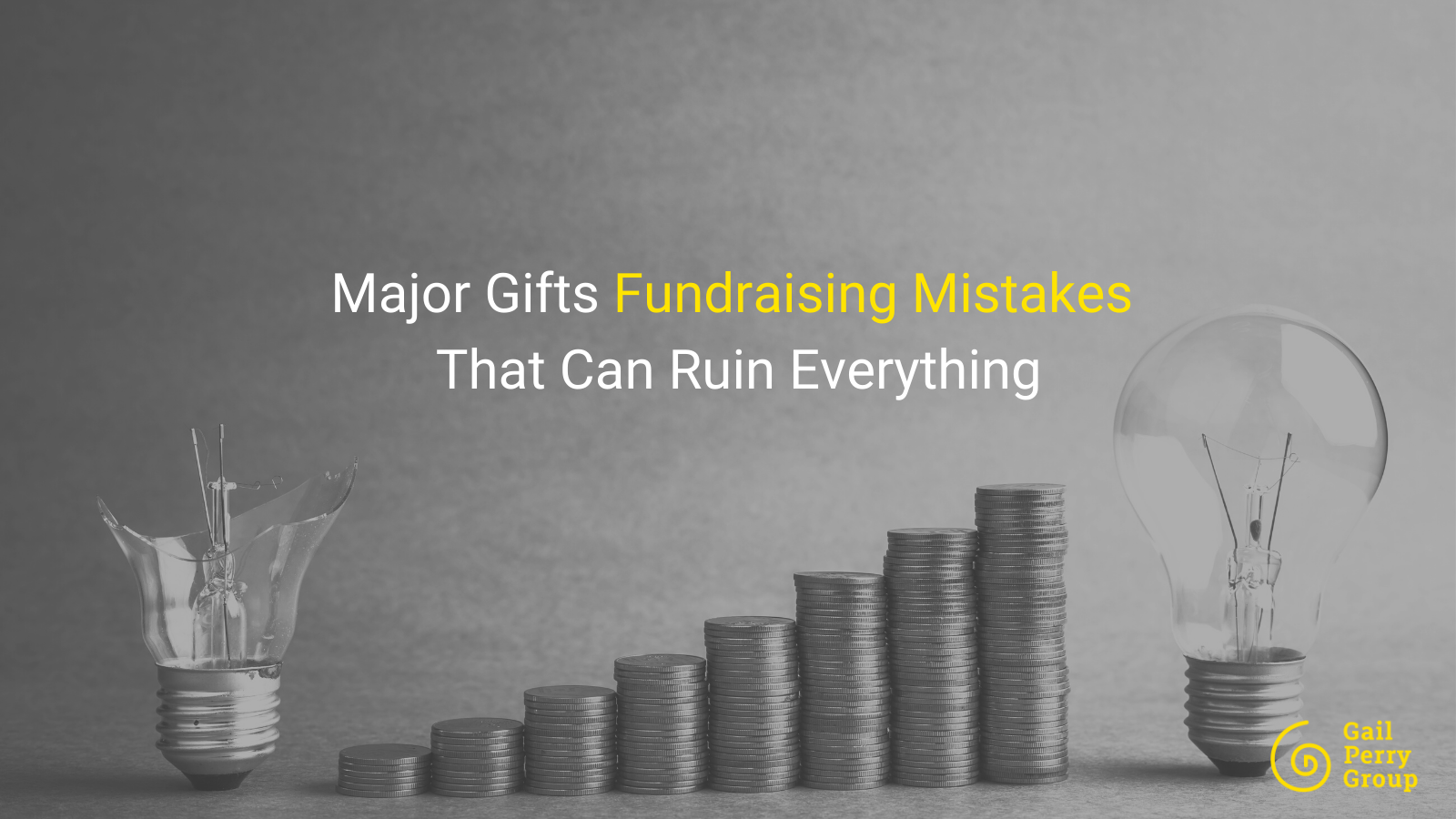There are many misunderstandings about the major gifts process, particularly among people who are not involved in the process. Major gift fundraising mistakes are everywhere.
Many managers of major gift teams push for the strategies we are describing below. But these steps take you in the wrong direction – away from your donors and their gifts.
1. Rush to ask for gifts, in order to meet short-term financial goals?
Often many fundraisers face a dilemma: On one hand, you have your own goals and financial targets to meet.
But is your donor really ready to give according to your schedule? In fact, she may be on a completely different time schedule. She may not have even thought about that six-figure gift that you’ve been dreaming and planning for.
Receive expert advice. Direct to your inbox.
If you move too quickly to ask a major donor for their gift, everything – and I mean everything – may backfire. Asking too quickly can feel like an affront to your donor.
She really doesn’t like being treated like an ATM. It makes her dislike you and even avoid you. If she thinks all you want from her is her money, she will feel empty, used, or even taken advantage of.
Takeaway: Your fundraising goals are important, but your donor’s personal timetable must take precedence.
2. Overly impressed by the wealth capacity in your donor screening data?
Ah, the golden key that wealth screening offers, promises to identify the wealthy donors in your database. Yes, it’s quite useful. However, it may send you in the wrong direction.
We often see fundraisers blinded by capacity ratings. When fundraisers focus on capacity alone, they can waste a lot of time.
The problem is, focusing on capacity alone means that you are approaching highly-rated prospects who may not be particularly interested or involved. The path to a major gift can be very, very long with these people.
Above all, they are not going to be a quick donor; that is unless they are deeply passionate about your cause. When that is the case, you do have a wonderful major gift prospect.
Takeaway: When reviewing prospects from your wealth screening data, be sure to evaluate the other factors that make a great prospect – interest, and accessibility.
Partner with us.
Find out how we can help you achieve your fundraising goals with world-class consulting and custom training.
3. Major gift fundraising mistakes: Seeking major gifts without a structure?
When there is little structure to a major gift effort, your fundraising team ends up shooting from the hip, guessing what to do next.
So many clients have come to us, asking for help in where to focus. Who should they pick up the phone and call, and who should they put on the backburner? When you don’t know where to spend your time and you are just guessing your way along, then you are pretty much lost.
There’s no systematic evaluation of which donors to focus on first. We see so many fundraising shops with unorganized, unplanned efforts. These shops are making many major gift fundraising mistakes. They need a careful, systematic approach – grounded in data.
Our signature method of structuring capital campaigns and major gifts initiatives, Fundraising by the Numbers, helps fundraising teams evaluate their prospects, and sets up a systematic approach to the largest donors first.
Takeaway: You need a system and a structure if you want to be successful in major gift fundraising.
4. Too many donors in each person’s portfolio?
Loading too many donors in a portfolio is a surefire way to dilute your efforts. There is no way that one person can develop close relationships with 125 people. There are simply not enough hours in the day or week. You must be realistic about how many prospects you can realistically cover and cultivate.
Often we’ve seen development managers load up portfolios with prospects who are not qualified, and who do not offer significant potential. Yet the fundraiser is tasked with developing relationships with these individuals.
The best anyone can do is manage 60 relationships with people well. We recommend that the rest of the prospects in a portfolio are sorted by priority and put on the backburner.
Takeaway: Your fundraising totals will be higher if you restrict yourself to fewer donors.
5. Asking for gifts without involving or engaging your donors?
Most of us know that larger, transformational gifts come from long-term relationships with donors. A large gift is the product of many conversations with a donor.
In addition, we know that the more a donor is involved or engaged, then the more they will give.
It stands to reason that the donors who really understand your work and get to know your leadership are the ones who tend to make the big contributions.
One leads to the other. The involvement leads to the investment.
A frequent major gift fundraising mistake we see is that managers may push fundraisers out the door to “just ask.” Guess what – this will backfire on you. Because, as we mentioned above, moving too quickly to the ask, without enough engagement, will result in a small gift.
Whereas, long-term nurturing of a major donor relationship can result in gift after gift after gift – culminating in a large bequest!
Takeaway: Develop a trusting relationship first. Then ask.
Bottom Line: Don’t make these major gift fundraising mistakes with your team – pay attention to your donors and your process.
As always, it is a pleasure to share our weekly insights with you as we cover important fundraising strategies.
If your organization is planning a capital campaign or expanding your major gifts program – we can help. Send an email to coaching@gailperry.com if you’d like to schedule a free strategy call with us.




